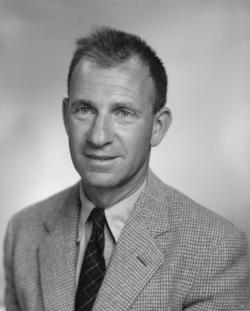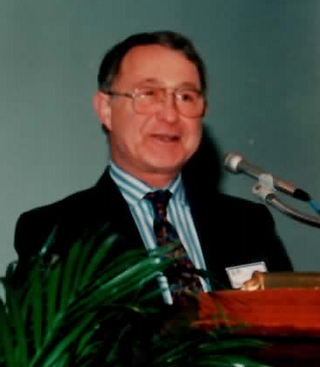Related Research Articles

William Maurice "Doc" Ewing was an American geophysicist and oceanographer.

Don Lynn Anderson was an American geophysicist who made significant contributions to the understanding of the origin, evolution, structure, and composition of Earth and other planets. An expert in numerous scientific disciplines, Anderson's work combined seismology, solid state physics, geochemistry and petrology to explain how the Earth works. Anderson was best known for his contributions to the understanding of the Earth's deep interior, and more recently, for the plate theory hypothesis that hotspots are the product of plate tectonics rather than narrow plumes emanating from the deep Earth. Anderson was Professor (Emeritus) of Geophysics in the Division of Geological and Planetary Sciences at the California Institute of Technology (Caltech). He received numerous awards from geophysical, geological and astronomical societies. In 1998 he was awarded the Crafoord Prize by the Royal Swedish Academy of Sciences along with Adam Dziewonski. Later that year, Anderson received the National Medal of Science. He held honorary doctorates from Rensselaer Polytechnic Institute and the University of Paris (Sorbonne), and served on numerous university advisory committees, including those at Harvard, Princeton, Yale, University of Chicago, Stanford, University of Paris, Purdue University, and Rice University. Anderson's wide-ranging research resulted in hundreds of published papers in the fields of planetary science, seismology, mineral physics, petrology, geochemistry, tectonics and the philosophy of science.
Keith Edward Bullen FAA FRS was a New Zealand-born mathematician and geophysicist. He is noted for his seismological interpretation of the deep structure of the Earth's mantle and core. He was Professor of Applied Mathematics at the University of Sydney in Australia from 1945 until 1971.

Walter Heinrich Munk was an American physical oceanographer. He was one of the first scientists to bring statistical methods to the analysis of oceanographic data. His work won awards including the National Medal of Science, the Kyoto Prize, and induction to the French Legion of Honour.
Leon Knopoff was a geophysicist and musicologist. He received his education at Caltech, graduating in 1949 with a PhD in physics, and came to UCLA the following year. He served on the UCLA faculty for 60 years. His research interests spanned a wide variety of fields and included the physics and statistics of earthquakes, earthquake prediction, the interior structure of the Earth, plate tectonics, pattern recognition, non-linear earthquake dynamics and several other areas of solid Earth geophysics. He also made contributions to the fields of musical perception and archaeology.
Irwin Ira Shapiro is an American astrophysicist and Timken University Professor at Harvard University. He has been a professor at Harvard since 1982. He was the director of the Center for Astrophysics | Harvard & Smithsonian from 1982 to 2004.
(Stanley) Keith Runcorn was a British physicist whose paleomagnetic reconstruction of the relative motions of Europe and America revived the theory of continental drift and was a major contribution to plate tectonics.

Michael Selwyn Longuet-Higgins FRS was a mathematician and oceanographer at the Department of Applied Mathematics and Theoretical Physics (DAMTP), Cambridge University, England and Institute for Nonlinear Science, University of California, San Diego, USA. He was the younger brother of H. Christopher Longuet-Higgins.
Victor Vacquier, Sr. was a professor of geophysics at the Scripps Institution of Oceanography at the University of California, San Diego.

Chaim Leib Pekeris was an Israeli-American physicist and mathematician. He made notable contributions to geophysics and the spectral theory of many-electron atoms, in particular the Helium atom. He was also one of the designers of the first computer in Israel, WEIZAC.

Sean Carl Solomon is the director of the Lamont–Doherty Earth Observatory of Columbia University, where he is also the William B. Ransford Professor of Earth and Planetary Science. Before moving to Columbia in 2012, he was the director of the Department of Terrestrial Magnetism at the Carnegie Institute in Washington, D.C. His research area is in geophysics, including the fields of planetary geology, seismology, marine geophysics, and geodynamics. Solomon is the principal investigator on the NASA MESSENGER mission to Mercury. He is also a team member on the Gravity Recovery and Interior Laboratory mission and the Plume-Lithosphere Undersea Melt Experiment (PLUME).
Robert L. Parker is an American geophysicist and mathematician, currently holding a Professor Emeritus of Geophysics position at the Scripps Institution of Oceanography at the University of California, San Diego in La Jolla, California.

James Freeman Gilbert was an American geophysicist, best known for his work with George E. Backus on inverting geophysical data, and also for his role in establishing an international network of long-period seismometers.

Anthony Brian Watts FRS is a British marine geologist and geophysicist and Professor of Marine Geology and Geophysics in the Department of Earth Sciences, at the University of Oxford.
Sethunathasarma Krishnaswami (1945–2015), popularly known as Swami, was an Indian geochemist and an honorary scientist at the geosciences division of the Physical Research Laboratory. He was known for his studies on low temperature geochemistry and was an elected fellow of the Indian Academy of Sciences, Indian National Science Academy, The World Academy of Sciences, National Academy of Sciences, India, American Geophysical Union, Geochemical Society and European Association of Geochemistry (2003). The Council of Scientific and Industrial Research, the apex agency of the Government of India for scientific research, awarded him the Shanti Swarup Bhatnagar Prize for Science and Technology, one of the highest Indian science awards for his contributions to Earth, atmosphere, ocean and planetary Sciences in 1984.
David Gubbins is a British former geophysicist concerned with the mechanism of the Earth's magnetic field and theoretical geophysics. He is Emeritus Professor of Earth Sciences at Leeds University.
Lisa Tauxe is a geophysicist, professor and former department chair at the Scripps Institution of Oceanography at UC San Diego. Tauxe is a researcher and international authority on the behavior of the ancient geomagnetic field and applications of paleomagnetism to geological problems.
John Henry Woodhouse is an English geophysicist, Emeritus Professor in the Department of Earth Sciences at the University of Oxford.
Catherine G. Constable is an Australian earth scientist who is a professor at the Scripps Institution of Oceanography. Her research considers palaeo- and geo-magnetism. Constable was awarded the American Geophysical Union William Gilbert Award in 2013 and elected Fellow of the American Association for the Advancement of Science in 2017.
References
- 1 2 "Backus, George Edward" (in French). Institut de France. Retrieved 10 September 2011.[ permanent dead link ]
- ↑ "J. Freeman Gilbert Receives 1999 William Bowie Medal". American Geophysical Union. Retrieved 10 September 2011.[ permanent dead link ]
- ↑ Ashley P. Willis; Art R.T. Jonkers (2007). David Gubbins; Emilio Herrero-Bervera (eds.). Encyclopedia of geomagnetism and paleomagnetism. Springer. pp. 164 and 360.
- ↑ "George E. Backus, Professor Emeritus". Archived from the original on July 24, 2008.
- ↑ "Winners of the Gold Medal of the Royal Astronomical Society". Royal Astronomical Society. Archived from the original on 25 May 2011. Retrieved 10 September 2011.
- ↑ "Awards & Honors". American Geophysical Union. Archived from the original on 29 January 2012. Retrieved 10 September 2011.
- ↑ "AGU Fellows". American Geophysical Union. Archived from the original on 2 February 2012. Retrieved 10 September 2011.
- ↑ "Seven win Guggenheim Fellows". University of California, San Diego. Archived from the original on 13 September 2011. Retrieved 10 September 2011.
- ↑ "George Edward Backus". John Simon Guggenheim Memorial Foundation. Archived from the original on 11 November 2011. Retrieved 10 September 2011.
- ↑ Annual Report – Fiscal Year 1968–1969 (Report). National Academy of Sciences and National Academy of Engineering (National Research Council).
- ↑ "Chapter B" (PDF). Members of the American Academy of Arts and Sciences: 1780–2011. p. 23.
- ↑ "History – 1990–2000: New Premises". Institute of Geophysics and Planetary Physics. Archived from the original on 2011-08-23.